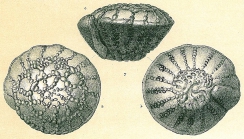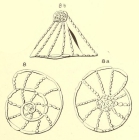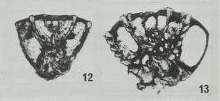
| Intro | | About | | Wiki | | Search traits | | Data explorer | | Literature | | Definitions | | Sources | | Webservices | | Statistics | | Feedback | | Editors | | Log in |
Foraminifera taxon detailsPseudorotalia Reiss & Merling, 1958
484811 (urn:lsid:marinespecies.org:taxname:484811)
accepted
Genus
Rotalia schroeteriana Parker & Jones in Carpenter, 1862 accepted as Pseudorotalia schroeteriana (Parker & Jones in Carpenter, 1862) (type by original designation)
marine,
feminine
Reiss, Z.; Merling, P. (1958). Structure of some Rotaliidea. <em>Bulletin / Geological Survey of Israel.</em> 21:1–19.
page(s): p. 13 [details]
Diagnosis Test large, subconical, planoconvex and trochospiral with two to four gradually enlarging whorls, ten to twenty chambers in...
Diagnosis Test large, subconical, planoconvex and trochospiral with two to four gradually enlarging whorls, ten to twenty chambers in the final whorl, spiral side flat and umbilical side strongly elevated, sutures nearly straight and radial to slightly oblique on the spiral side, straight and radial on the umbilical side, elevated and limbate on both sides but commonly broken into beads or nodes by the rows of openings into the canal system, imperforate umbilical lips extend into the narrow umbilicus and are thickened by secondary lamellae as new chambers are added, producing a cavity filled umbilical mass that is perforated by a few large rounded openings into the umbilical canal system, intraseptal canals open to the exterior by a double row of alternating sutural pores on both sides of the test, periphery acute and with imperforate keel; wall calcareous, of lamellar fibrous calcite, optically radial, coarsely perforate; aperture interiomarginal on umbilical side, partly covered by narrow extension of apertural face. U. Miocene to Holocene; Borneo; New Guinea; Australia. (Loeblich & Tappan, 1987, Foraminiferal Genera and Their Classification) [details]
Hayward, B.W.; Le Coze, F.; Vachard, D.; Gross, O. (2025). World Foraminifera Database. Pseudorotalia Reiss & Merling, 1958. Accessed at: https://www.marinespecies.org/foraminifera/aphia.php?p=taxdetails&id=484811 on 2025-05-23
Date action by
original description
Reiss, Z.; Merling, P. (1958). Structure of some Rotaliidea. <em>Bulletin / Geological Survey of Israel.</em> 21:1–19.
page(s): p. 13 [details] additional source Loeblich, A. R.; Tappan, H. (1987). Foraminiferal Genera and their Classification. Van Nostrand Reinhold Company, New York. 970pp., available online at https://books.google.pt/books?id=n_BqCQAAQBAJ [details] Available for editors From editor or global species database
Diagnosis Test large, subconical, planoconvex and trochospiral with two to four gradually enlarging whorls, ten to twenty chambers in the final whorl, spiral side flat and umbilical side strongly elevated, sutures nearly straight and radial to slightly oblique on the spiral side, straight and radial on the umbilical side, elevated and limbate on both sides but commonly broken into beads or nodes by the rows of openings into the canal system, imperforate umbilical lips extend into the narrow umbilicus and are thickened by secondary lamellae as new chambers are added, producing a cavity filled umbilical mass that is perforated by a few large rounded openings into the umbilical canal system, intraseptal canals open to the exterior by a double row of alternating sutural pores on both sides of the test, periphery acute and with imperforate keel; wall calcareous, of lamellar fibrous calcite, optically radial, coarsely perforate; aperture interiomarginal on umbilical side, partly covered by narrow extension of apertural face. U. Miocene to Holocene; Borneo; New Guinea; Australia. (Loeblich & Tappan, 1987, Foraminiferal Genera and Their Classification) [details]
From editor or global species database
Image from typetaxon
Image from typetaxon
Image from typetaxon
Image from typetaxon
|




